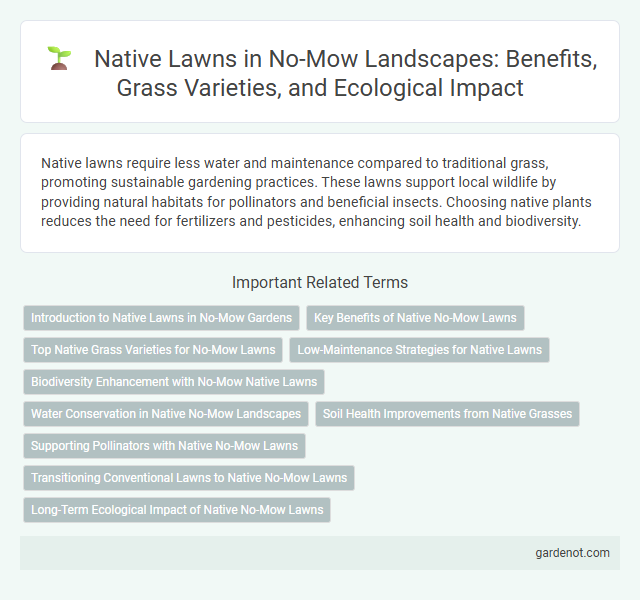Native lawns require less water and maintenance compared to traditional grass, promoting sustainable gardening practices. These lawns support local wildlife by providing natural habitats for pollinators and beneficial insects. Choosing native plants reduces the need for fertilizers and pesticides, enhancing soil health and biodiversity.
Introduction to Native Lawns in No-Mow Gardens
Native lawns in no-mow gardens offer an eco-friendly alternative by using indigenous grasses and plants adapted to local climates, reducing water and maintenance needs significantly. These lawns support biodiversity by providing habitat for native insects, birds, and other wildlife while minimizing the use of fertilizers and pesticides. Emphasizing native species ensures a resilient, low-maintenance landscape that thrives naturally without regular mowing or intensive care.
Key Benefits of Native No-Mow Lawns
Native no-mow lawns offer substantial ecological advantages by supporting local biodiversity and providing habitat for pollinators such as bees and butterflies. These lawns require minimal maintenance, reducing water usage and eliminating the need for chemical fertilizers and pesticides, which enhances soil health. Their deep-rooted native plants improve soil structure, increase drought resilience, and help prevent erosion, making them a sustainable landscaping choice.
Top Native Grass Varieties for No-Mow Lawns
Blue grama (Bouteloua gracilis), buffalo grass (Buchloe dactyloides), and fine fescues such as hard fescue (Festuca trachyphylla) are top native grass varieties ideal for no-mow lawns due to their low growth habits and drought tolerance. These grasses establish dense, resilient turf that minimizes maintenance by naturally growing to a manageable height, reducing the need for frequent mowing. Incorporating native species enhances biodiversity and supports local ecosystems while maintaining an attractive, eco-friendly lawn solution.
Low-Maintenance Strategies for Native Lawns
Native lawns thrive with low-maintenance strategies such as selecting drought-tolerant grasses like buffalo grass or blue grama, which reduce the need for frequent watering and mowing. Incorporating organic mulch and proper soil aeration enhances root health and moisture retention, minimizing irrigation. These sustainable practices support biodiversity while maintaining a healthy, resilient native lawn with minimal effort.
Biodiversity Enhancement with No-Mow Native Lawns
No-mow native lawns significantly enhance biodiversity by providing essential habitats for pollinators, birds, and beneficial insects, fostering a balanced ecosystem. These lawns support native flora, which is better adapted to local soil and climate conditions, reducing the need for water, fertilizers, and pesticides. Incorporating native grasses and wildflowers promotes soil health while creating a sustainable and low-maintenance landscape that benefits urban and suburban environments.
Water Conservation in Native No-Mow Landscapes
Native no-mow lawns drastically reduce water usage by relying on drought-tolerant grasses and plants adapted to local climates. Deep root systems in native species enhance soil moisture retention and decrease irrigation frequency. This sustainable landscaping choice conserves water while supporting local biodiversity and ecosystem health.
Soil Health Improvements from Native Grasses
Native grasses significantly enhance soil health by improving soil structure, increasing organic matter, and boosting microbial activity. Their deep root systems promote water infiltration and nutrient cycling, reducing erosion and promoting long-term soil fertility. These natural processes create resilient soils that support sustainable no-mow lawn ecosystems.
Supporting Pollinators with Native No-Mow Lawns
Native no-mow lawns provide vital habitats for pollinators like bees, butterflies, and hummingbirds by offering diverse native flowering plants that bloom throughout the growing season. These low-maintenance landscapes reduce the need for mowing and chemical inputs, promoting healthier ecosystems and enhancing biodiversity. Incorporating native grasses and wildflowers in no-mow lawns supports essential pollinator populations, contributing to sustainable garden practices and environmental conservation.
Transitioning Conventional Lawns to Native No-Mow Lawns
Transitioning conventional lawns to native no-mow lawns reduces water consumption by up to 50% and enhances local biodiversity by supporting native pollinators and wildlife. Native grasses like buffalo grass and wildflowers such as purple coneflower establish deep root systems that improve soil health and minimize erosion. Maintaining a native lawn requires less fertilizer and eliminates the need for frequent mowing, resulting in lower carbon emissions and cost savings.
Long-Term Ecological Impact of Native No-Mow Lawns
Native no-mow lawns promote biodiversity by supporting local flora and fauna, creating habitats for pollinators and beneficial insects essential to ecosystem health. These lawns enhance soil quality and water retention through deep-rooted native plants, reducing erosion and the need for chemical fertilizers or pesticides. Over time, native no-mow lawns contribute to carbon sequestration and mitigate urban heat island effects, fostering a sustainable and resilient environment.
Native lawn Infographic

 gardenot.com
gardenot.com